Evaluation of Thermal Comfort in Urban Commercial Space with Vision–Language-Model-Based Agent Model
Abstract
1. Introduction
2. Materials and Methods
2.1. Study Area
2.2. Data Collection
2.3. Thermal Comfort Evaluation Based on VLM Agents
2.4. Analysis of the Relationship Between Thermal Comfort and Commercial Viability
3. Results
3.1. Validation of VLM-Based Thermal Comfort Assessment
3.2. Difference in Perceived Thermal Comfort Between Agents
3.3. Identifying Agent Decision-Making Environment Factors
4. Discussion
4.1. Findings and Advantages of VLM-Based Agents
4.2. Implications for Urban Development Policy and Practice
4.3. Scientific Contribution of the Practical Approach
4.4. Research Limitations
5. Conclusions
Author Contributions
Funding
Data Availability Statement
Conflicts of Interest
References
- Ma, X.; Yang, J.; Zhang, R.; Yu, W.; Ren, J.; Xiao, X.; Xia, J. XGBoost-Based Analysis of the Relationship Between Urban 2-D/3-D Morphology and Seasonal Gradient Land Surface Temperature. IEEE J. Sel. Top. Appl. Earth Obs. Remote Sens. 2024, 17, 4109–4124. [Google Scholar] [CrossRef]
- Yuan, Y.; Li, X.; Wang, H.; Geng, X.; Gu, J.; Fan, Z.; Wang, X.; Liao, C. Unraveling the Global Economic and Mortality Effects of Rising Urban Heat Island Intensity. Sustain. Cities Soc. 2024, 116, 105902. [Google Scholar] [CrossRef]
- Zhang, Q.; Yang, J.; Ma, X.; Xin, J.; Ren, J.; Yu, W.; Xiao, X.; Xia, J. Influence of 2-D/3-D Urban Morphology on Diurnal Land Surface Temperature from the Perspective of Functional Zones. IEEE J. Sel. Top. Appl. Earth Obs. Remote Sens. 2024, 17, 17036–17051. [Google Scholar] [CrossRef]
- Liu, S.; Kwok, Y.-T.; Lau, K.; Ng, E. Applicability of Different Extreme Weather Datasets for Assessing Indoor Overheating Risks of Residential Buildings in a Subtropical High-Density City. Build. Environ. 2021, 194, 107711. [Google Scholar] [CrossRef]
- Qian, B.; Yu, T.; Zhang, C.; Heiselberg, P.K.; Lei, B.; Yang, L. Suitability of Heat Wave Event Definitions for Assessing Indoor Overheating in Current and Future Climate: A Case Study in China. Build. Environ. 2023, 241, 110487. [Google Scholar] [CrossRef]
- Kenny, G.P.; Tetzlaff, E.J.; Journeay, W.S.; Henderson, S.B.; O’Connor, F.K. Indoor Overheating: A Review of Vulnerabilities, Causes, and Strategies to Prevent Adverse Human Health Outcomes during Extreme Heat Events. Temperature 2024, 11, 203–246. [Google Scholar] [CrossRef]
- Zheng, P.; Wu, H.; Liu, Y.; Ding, Y.; Yang, L. Thermal Comfort in Temporary Buildings: A Review. Build. Environ. 2022, 221, 109262. [Google Scholar] [CrossRef]
- Hampo, C.C.; Schinasi, L.H.; Hoque, S. Surviving Indoor Heat Stress in United States: A Comprehensive Review Exploring the Impact of Overheating on the Thermal Comfort, Health, and Social Economic Factors of Occupants. Heliyon 2024, 10, e25801. [Google Scholar] [CrossRef]
- Mahmoud, R.M.A.; Abdallah, A.S.H. Assessment of Outdoor Shading Strategies to Improve Outdoor Thermal Comfort in School Courtyards in Hot and Arid Climates. Sustain. Cities Soc. 2022, 86, 104147. [Google Scholar] [CrossRef]
- Papadakis, N.; Katsaprakakis, D.A. A Review of Energy Efficiency Interventions in Public Buildings. Energies 2023, 16, 6329. [Google Scholar] [CrossRef]
- Zhang, A.; Li, W.; Wu, J.; Lin, J.; Chu, J.; Xia, C. How Can the Urban Landscape Affect Urban Vitality at the Street Block Level? A Case Study of 15 Metropolises in China. Environ. Plan. B Urban Anal. City Sci. 2021, 48, 1245–1262. [Google Scholar] [CrossRef]
- Hu, L.; Yan, J.; Zhu, Y.; Deng, J.; Chen, L.; Lu, S. Research on the Sustainable Design of Commercial Street Space Based on Importance Performance Analysis. Buildings 2022, 12, 2096. [Google Scholar] [CrossRef]
- Spagnolo, J.; de Dear, R. A Field Study of Thermal Comfort in Outdoor and Semi-Outdoor Environments in Subtropical Sydney Australia. Build. Environ. 2003, 38, 721–738. [Google Scholar] [CrossRef]
- Zheng, H.; Long, E.; Cheng, Z.; Yang, Z.; Jia, Y. Experimental Exploration on Airtightness Performance of Residential Buildings in the Hot Summer and Cold Winter Zone in China. Build. Environ. 2022, 214, 108848. [Google Scholar] [CrossRef]
- Baobeid, A.; Koç, M.; Al-Ghamdi, S.G. Walkability and Its Relationships with Health, Sustainability, and Livability: Elements of Physical Environment and Evaluation Frameworks. Front. Built Environ. 2021, 7, 721218. [Google Scholar] [CrossRef]
- Bai, M.; Hu, R.; Lian, H.; Zhou, W. Correlation Study of Commercial Street Morphology and Pedestrian Activity in Cold Region Summers under Thermal Comfort Guidance: A Case Study of Sanlitun, Beijing. Buildings 2024, 14, 1751. [Google Scholar] [CrossRef]
- Ghasemi, S. Investigating the Relationship between Outdoor Thermal Comfort and User Behaviour Patterns in Public Open Spaces in a Winter City: An Empirical Study of Oodi Library Plaza in Helsinki. Available online: http://www.theseus.fi/handle/10024/866784 (accessed on 23 February 2025).
- Guo, H.; Huang, L.; Song, W.; Wang, X.; Wang, H.; Zhao, X. Evaluation of the Summer Overheating Phenomenon in Reinforced Concrete and Cross Laminated Timber Residential Buildings in the Cold and Severe Cold Regions of China. Energies 2020, 13, 6305. [Google Scholar] [CrossRef]
- Davies, W.K.D. Winter Cities. In Theme Cities: Solutions for Urban Problems; Davies, W.K.D., Ed.; Springer: Dordrecht, The Netherlands, 2015; pp. 277–310. ISBN 978-94-017-9655-2. [Google Scholar]
- Mills, B.N. Understanding the Influence of Weather and Warning Information on Trip and Activity Decisions, Behaviour, and Risk Outcomes. Ph.D. Thesis, University of Waterloo, Waterloo, ON, Canada, 10 September 2021. [Google Scholar]
- Yin, Q.; Cao, Y.; Sun, C. Research on Outdoor Thermal Comfort of High-Density Urban Center in Severe Cold Area. Build. Environ. 2021, 200, 107938. [Google Scholar] [CrossRef]
- Eslamirad, N.; Sepúlveda, A.; De Luca, F.; Sakari Lylykangas, K.; Ben Yahia, S. Outdoor Thermal Comfort Optimization in a Cold Climate to Mitigate the Level of Urban Heat Island in an Urban Area. Energies 2023, 16, 4546. [Google Scholar] [CrossRef]
- Mao, Y.; Zhu, K.; Zheng, Z.; Fang, Z. Evaluation of the Thermal Comfort in Different Commercial Buildings in Guangzhou. Indoor Built Environ. 2024, 33, 391–413. [Google Scholar] [CrossRef]
- Zhang, Y.; Zheng, Z.; Zhang, S.; Fang, Z.; Lin, Z. Exploring Thermal Comfort and Pleasure in Outdoor Shaded Spaces: Inspiration for Improving Thermal Index Models. Build. Environ. 2024, 265, 111933. [Google Scholar] [CrossRef]
- Firrone, T.; Vitrano, R.M.; Fernandez, F.; Zagarella, F.; Garofalo, E. Environmental Design Principles for Urban Comfort: The Pilot Case Study of Naro Municipality. Buildings 2024, 14, 3885. [Google Scholar] [CrossRef]
- Nitidara, N.P.A.; Sarwono, J.; Suprijanto, S.; Soelami, F.X.N. The Multisensory Interaction between Auditory, Visual, and Thermal to the Overall Comfort in Public Open Space: A Study in a Tropical Climate. Sustain. Cities Soc. 2022, 78, 103622. [Google Scholar] [CrossRef]
- Ren, J.; Yang, J.; Zhang, Y.; Xiao, X.; Xia, J.C.; Li, X.; Wang, S. Exploring Thermal Comfort of Urban Buildings Based on Local Climate Zones. J. Clean. Prod. 2022, 340, 130744. [Google Scholar] [CrossRef]
- Yilmaz, S.; Mutlu, B.E.; Aksu, A.; Mutlu, E.; Qaid, A. Street Design Scenarios Using Vegetation for Sustainable Thermal Comfort in Erzurum, Turkey. Environ. Sci. Pollut. Res. 2021, 28, 3672–3693. [Google Scholar] [CrossRef]
- Speak, A.F.; Salbitano, F. Summer Thermal Comfort of Pedestrians in Diverse Urban Settings: A Mobile Study. Build. Environ. 2022, 208, 108600. [Google Scholar] [CrossRef]
- Liu, G.; Lei, J.; Qin, H.; Niu, J.; Chen, J.; Lu, J.; Han, G. Impact of Environmental Comfort on Urban Vitality in Small and Medium-Sized Cities: A Case Study of Wuxi County in Chongqing, China. Front. Public Health 2023, 11, 1131630. [Google Scholar] [CrossRef]
- Zou, M.; Zhang, H. Cooling Strategies for Thermal Comfort in Cities: A Review of Key Methods in Landscape Design. Environ. Sci. Pollut. Res. 2021, 28, 62640–62650. [Google Scholar] [CrossRef]
- Ji, Y.; Song, J.; Shen, P. A Review of Studies and Modelling of Solar Radiation on Human Thermal Comfort in Outdoor Environment. Build. Environ. 2022, 214, 108891. [Google Scholar] [CrossRef]
- Jin, Y. The Effect of Indoor Thermal and Humidity Condition on Older Occupants’ Subjective Comfort and Skin Condition in Winter. Ph.D. Thesis, Heriot-Watt University, Edinburgh, UK, 2021. [Google Scholar]
- Yau, Y.H.; Toh, H.S.; Chew, B.T.; Nik Ghazali, N.N. A Review of Human Thermal Comfort Model in Predicting Human–Environment Interaction in Non-Uniform Environmental Conditions. J. Therm. Anal Calorim. 2022, 147, 14739–14763. [Google Scholar] [CrossRef]
- Song, W.; Calautit, J.K. Inclusive Comfort: A Review of Techniques for Monitoring Thermal Comfort among Individuals with the Inability to Provide Accurate Subjective Feedback. Build. Environ. 2024, 257, 111463. [Google Scholar] [CrossRef]
- Laouadi, A. A New General Formulation for the PMV Thermal Comfort Index. Buildings 2022, 12, 1572. [Google Scholar] [CrossRef]
- Fabbri, K. The Indoor Thermal Comfort Indexes PMV and PPD. In Thermal Comfort Perception: A Questionnaire Approach Focusing on Children; Fabbri, K., Ed.; Springer International Publishing: Cham, The Switzerland, 2024; pp. 83–135. ISBN 978-3-031-52610-7. [Google Scholar]
- Ze Ze, C.B.; Nneme Nneme, L.; Monkam, L. PMVd/PPDd Model for Predicting Thermal Comfort in Air-Conditioned Buildings in Hot and Humid Regions of Sub-Saharan Africa. Int. J. Air-Cond. Ref. 2024, 32, 19. [Google Scholar] [CrossRef]
- Dzyuban, Y.; Ching, G.N.Y.; Yik, S.K.; Tan, A.J.; Banerjee, S.; Crank, P.J.; Chow, W.T.L. Outdoor Thermal Comfort Research in Transient Conditions: A Narrative Literature Review. Landsc. Urban Plan. 2022, 226, 104496. [Google Scholar] [CrossRef]
- Zhang, J.; Guo, W.; Cheng, B.; Jiang, L.; Xu, S. A Review of the Impacts of Climate Factors on Humans’ Outdoor Thermal Perceptions. J. Therm. Biol. 2022, 107, 103272. [Google Scholar] [CrossRef]
- Brocherie, F.; Girard, O.; Millet, G.P. Emerging Environmental and Weather Challenges in Outdoor Sports. Climate 2015, 3, 492–521. [Google Scholar] [CrossRef]
- Izzati, N.; Zaki, S.A.; Rijal, H.B.; Rey, J.A.A.; Hagishima, A.; Atikha, N. Investigation of Thermal Adaptation and Development of an Adaptive Model under Various Cooling Temperature Settings for Students’ Activity Rooms in a University Building in Malaysia. Buildings 2023, 13, 36. [Google Scholar] [CrossRef]
- Laezza, L.; De Dominicis, S.; Brondino, M. Reassessing Green Exercise Research: Unveiling Methodological Gaps and Pathways for Progress. Front. Sports Act. Living 2024, 6, 1449059. [Google Scholar] [CrossRef]
- Zhang, Y.; Chen, Y.; Su, Q.; Huang, X.; Li, Q.; Yang, Y.; Zhang, Z.; Chen, J.; Xiao, Z.; Xu, R.; et al. The Use of Machine and Deep Learning to Model the Relationship between Discomfort Temperature and Labor Productivity Loss among Petrochemical Workers. BMC Public Health 2024, 24, 3269. [Google Scholar] [CrossRef]
- Cuskley, C.; Sulik, J. The Burden for High-Quality Online Data Collection Lies with Researchers, Not Recruitment Platforms. Perspect. Psychol. Sci. 2024, 19, 891–899. [Google Scholar] [CrossRef]
- Wang, S.; Zhang, Q.; Gao, P.; Wang, C.; An, J.; Wang, L. Coupled Impact of Points of Interest and Thermal Environment on Outdoor Human Behavior Using Visual Intelligence. Buildings 2024, 14, 2978. [Google Scholar] [CrossRef]
- Yao, T.; Xu, Y.; Sun, L.; Liao, P.; Wang, J. Application of Machine Learning and Multi-Dimensional Perception in Urban Spatial Quality Evaluation: A Case Study of Shanghai Underground Pedestrian Street. Land 2024, 13, 1354. [Google Scholar] [CrossRef]
- Zhou, W.; Yang, M.; Yu, X.; Peng, Y.; Fan, C.; Xu, D.; Xiao, Q. Enhancing Thermal Comfort Prediction in High-Speed Trains through Machine Learning and Physiological Signals Integration. J. Therm. Biol. 2024, 121, 103828. [Google Scholar] [CrossRef] [PubMed]
- Luo, P.; Yu, B.; Li, P.; Liang, P.; Liang, Y.; Yang, L. How 2D and 3D Built Environments Impact Urban Surface Temperature under Extreme Heat: A Study in Chengdu, China. Build. Environ. 2023, 231, 110035. [Google Scholar] [CrossRef]
- Wei, X.; Guan, F.; Zhang, X.; Van de Weghe, N.; Huang, H. Integrating Planar and Vertical Environmental Features for Modelling Land Surface Temperature Based on Street View Images and Land Cover Data. Build. Environ. 2023, 235, 110231. [Google Scholar] [CrossRef]
- Ma, H.; Xu, Q.; Zhang, Y. High or Low? Exploring the Restorative Effects of Visual Levels on Campus Spaces Using Machine Learning and Street View Imagery. Urban For. Urban Green. 2023, 88, 128087. [Google Scholar] [CrossRef]
- Zhang, F.; Zhou, B.; Liu, L.; Liu, Y.; Fung, H.H.; Lin, H.; Ratti, C. Measuring Human Perceptions of a Large-Scale Urban Region Using Machine Learning. Landsc. Urban Plan. 2018, 180, 148–160. [Google Scholar] [CrossRef]
- Massaro, E.; Schifanella, R.; Piccardo, M.; Caporaso, L.; Taubenböck, H.; Cescatti, A.; Duveiller, G. Spatially-Optimized Urban Greening for Reduction of Population Exposure to Land Surface Temperature Extremes. Nat. Commun. 2023, 14, 2903. [Google Scholar] [CrossRef]
- Rui, Q.; Cheng, H. Quantifying the Spatial Quality of Urban Streets with Open Street View Images: A Case Study of the Main Urban Area of Fuzhou. Ecol. Indic. 2023, 156, 111204. [Google Scholar] [CrossRef]
- Liu, Y.; Cao, Z.; Wei, H.; Guo, P. Optimizing Spatial Distribution of Retail Shops against Neighborhood Tree Canopy Shade Using Big Data Extracted from Streetscape. Land 2024, 13, 1249. [Google Scholar] [CrossRef]
- Ma, H.; Zhang, Y.; Liu, P.; Zhang, F.; Zhu, P. How Does Spatial Structure Affect Psychological Restoration? A Method Based on Graph Neural Networks and Street View Imagery. Landsc. Urban Plan. 2024, 251, 105171. [Google Scholar] [CrossRef]
- Ogawa, Y.; Oki, T.; Zhao, C.; Sekimoto, Y.; Shimizu, C. Evaluating the Subjective Perceptions of Streetscapes Using Street-View Images. Landsc. Urban Plan. 2024, 247, 105073. [Google Scholar] [CrossRef]
- Shi, J.; Yan, Y.; Li, M.; Zhou, L. Measuring the Convergence and Divergence in Urban Street Perception among Residents and Tourists through Deep Learning: A Case Study of Macau. Land 2024, 13, 345. [Google Scholar] [CrossRef]
- Luo, J.; Zhao, T.; Cao, L.; Biljecki, F. Semantic Riverscapes: Perception and Evaluation of Linear Landscapes from Oblique Imagery Using Computer Vision. Landsc. Urban Plan. 2022, 228, 104569. [Google Scholar] [CrossRef]
- Chen, S.; Biljecki, F. Automatic Assessment of Public Open Spaces Using Street View Imagery. Cities 2023, 137, 104329. [Google Scholar] [CrossRef]
- Wang, L.; Han, X.; He, J.; Jung, T. Measuring Residents’ Perceptions of City Streets to Inform Better Street Planning through Deep Learning and Space Syntax. ISPRS J. Photogramm. Remote Sens. 2022, 190, 215–230. [Google Scholar] [CrossRef]
- Liang, X.; Chang, J.H.; Gao, S.; Zhao, T.; Biljecki, F. Evaluating Human Perception of Building Exteriors Using Street View Imagery. Build. Environ. 2024, 263, 111875. [Google Scholar] [CrossRef]
- Wu, W.; Li, L.; Li, C. Seasonal Variation in the Effects of Urban Environmental Factors on Land Surface Temperature in a Winter City. J. Clean. Prod. 2021, 299, 126897. [Google Scholar] [CrossRef]
- Cheng, A.-C.; Yin, H.; Fu, Y.; Guo, Q.; Yang, R.; Kautz, J.; Wang, X.; Liu, S. SpatialRGPT: Grounded Spatial Reasoning in Vision Language Models. Adv. Neural Inf. Process. Syst. 2025, 37, 135062–135093. Available online: https://proceedings.neurips.cc/paper_files/paper/2024/file/f38cb4cf9a5eaa92b3cfa481832719c6-Paper-Conference.pdf (accessed on 3 April 2025).
- Zhang, J.; Huang, J.; Jin, S.; Lu, S. Vision-Language Models for Vision Tasks: A Survey. IEEE Trans. Pattern Anal. Mach. Intell. 2024, 46, 5625–5644. [Google Scholar] [CrossRef]
- Feng, J.; Zhang, J.; Liu, T.; Zhang, X.; Ouyang, T.; Yan, J.; Du, Y.; Guo, S.; Li, Y. CityBench: Evaluating the Capabilities of Large Language Models for Urban Tasks. 2024. Available online: https://openreview.net/pdf?id=oIWN7eMhTb (accessed on 3 April 2025).
- Mansi, S.A.; Pigliautile, I.; Arnesano, M.; Pisello, A.L. A Novel Methodology for Human Thermal Comfort Decoding via Physiological Signals Measurement and Analysis. Build. Environ. 2022, 222, 109385. [Google Scholar] [CrossRef]
- Lau, K.K.-L.; Choi, C.Y. The Influence of Perceived Aesthetic and Acoustic Quality on Outdoor Thermal Comfort in Urban Environment. Build. Environ. 2021, 206, 108333. [Google Scholar] [CrossRef]
- Cui, H.; Wu, Y.; He, Y.; Li, N.; Li, B.; Gao, Y.; Jiang, A. Relative Thermal Pleasure Model: A Unified Framework for Understanding and Predicting Thermal Comfort in Dynamic Environments. J. Build. Eng. 2024, 87, 109020. [Google Scholar] [CrossRef]
- Jiang, Y.; Du, G.; Teng, H.; Wang, J.; Li, H. Multi-Scenario Land Use Change Simulation and Spatial Response of Ecosystem Service Value in Black Soil Region of Northeast China. Land 2023, 12, 962. [Google Scholar] [CrossRef]
- Bao, W.; Gong, A.; Zhang, T.; Zhao, Y.; Li, B.; Chen, S. Mapping Population Distribution with High Spatiotemporal Resolution in Beijing Using Baidu Heat Map Data. Remote Sens. 2023, 15, 458. [Google Scholar] [CrossRef]
- Fu, X.; Zhang, M.; Hao, J.; Han, P.; Zhang, H.; Shi, L.; Tang, H. What Can VLMs Do for Zero-Shot Embodied Task Planning? ICML 2024 Workshop on LLMs and Cognition. 2024. Available online: https://openreview.net/pdf?id=OE5WKiNPyx (accessed on 3 April 2025).
- Zhao, J.; Huang, J.X.; Deng, H.; Chang, Y.; Xia, L. Are Topics Interesting or Not? An LDA-Based Topic-Graph Probabilistic Model for Web Search Personalization. ACM Trans. Inf. Syst. 2022, 40, 51:1–51:24. [Google Scholar] [CrossRef]
- Qi, Y.; Li, H.; Song, Y.; Wu, X.; Luo, J. How Vision-Language Tasks Benefit from Large Pre-Trained Models: A Survey. arXiv 2024, arXiv:2412.08158. [Google Scholar]
- Šverko, Z.; Vrankić, M.; Vlahinić, S.; Rogelj, P. Complex Pearson Correlation Coefficient for EEG Connectivity Analysis. Sensors 2022, 22, 1477. [Google Scholar] [CrossRef]
- Vecellio, D.J.; Vanos, J.K.; Kennedy, E.; Olsen, H.; Richardson, G.R.A. An Expert Assessment on Playspace Designs and Thermal Environments in a Canadian Context. Urban Clim. 2022, 44, 101235. [Google Scholar] [CrossRef]
- Ashqar, H.I.; Alhadidi, T.I.; Elhenawy, M.; Khanfar, N.O. Leveraging Multimodal Large Language Models (MLLMs) for Enhanced Object Detection and Scene Understanding in Thermal Images for Autonomous Driving Systems. Automation 2024, 5, 508–526. [Google Scholar] [CrossRef]
- Li, X.; Wen, C.; Hu, Y.; Yuan, Z.; Zhu, X.X. Vision-Language Models in Remote Sensing: Current Progress and Future Trends. IEEE Geosci. Remote Sens. Mag. 2024, 12, 32–66. [Google Scholar] [CrossRef]
- Laurençon, H.; Marafioti, A.; Sanh, V.; Tronchon, L. Building and Better Understanding Vision-Language Models: Insights and Future Directions. Workshop on Responsibly Building the Next Generation of Multimodal Foundational Models. 2024. Available online: https://openreview.net/forum?id=iSL0FHZStr (accessed on 3 April 2025).
- Li, Z.; Wu, X.; Du, H.; Nghiem, H.; Shi, G. Benchmark Evaluations, Applications, and Challenges of Large Vision Language Models: A Survey. arXiv 2025, arXiv:2501.02189. [Google Scholar]
- Tao, L.; Zhang, H.; Jing, H.; Liu, Y.; Yan, D.; Wei, G.; Xue, X. Advancements in Vision–Language Models for Remote Sensing: Datasets, Capabilities, and Enhancement Techniques. Remote Sens. 2025, 17, 162. [Google Scholar] [CrossRef]
- Lyu, R.; Pang, J.; Tian, X.; Zhao, W.; Zhang, J. How to Optimize the 2D/3D Urban Thermal Environment: Insights Derived from UAV LiDAR/Multispectral Data and Multi-Source Remote Sensing Data. Sustain. Cities Soc. 2023, 88, 104287. [Google Scholar] [CrossRef]
- Yao, S.; Ghorbany, S.; Sisk, M.; Hu, M.; Wang, C. Leveraging Zero-Shot Learning on Street-View Imagery for Built Environment Variable Analysis. In Proceedings of the Advances in Visual Computing; Bebis, G., Patel, V., Gu, J., Panetta, J., Gingold, Y., Johnsen, K., Arefin, M.S., Dutta, S., Biswas, A., Eds.; Springer Nature: Cham, Switzerland, 2025; pp. 243–254. [Google Scholar]
- Wang, Y.; Chen, S.-Y.; Zhou, Z.; Li, S.; Li, H.; Zhou, W.; Li, H. ROOT: VLM Based System for Indoor Scene Understanding and Beyond. arXiv 2024, arXiv:2411.15714. [Google Scholar]
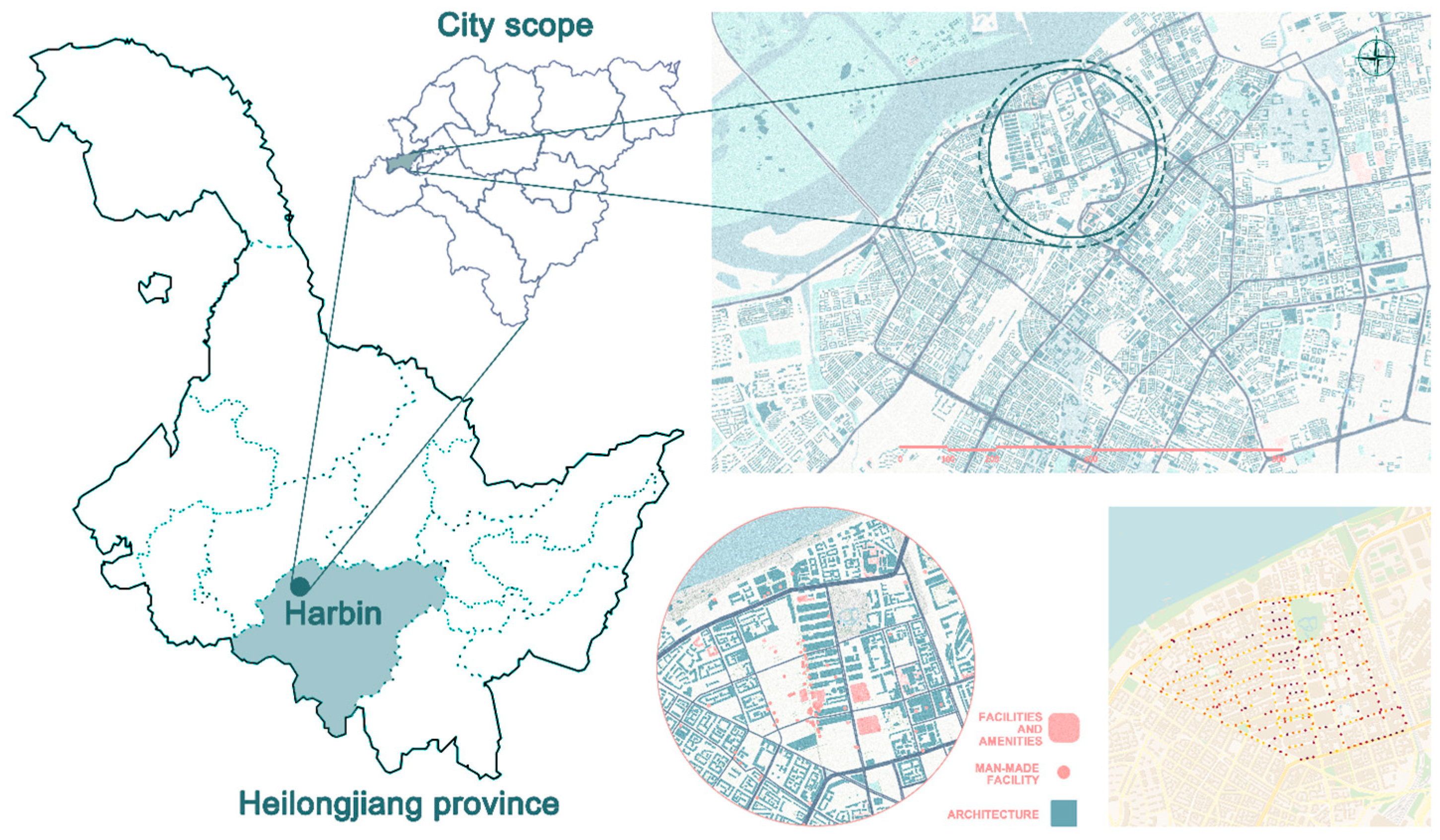
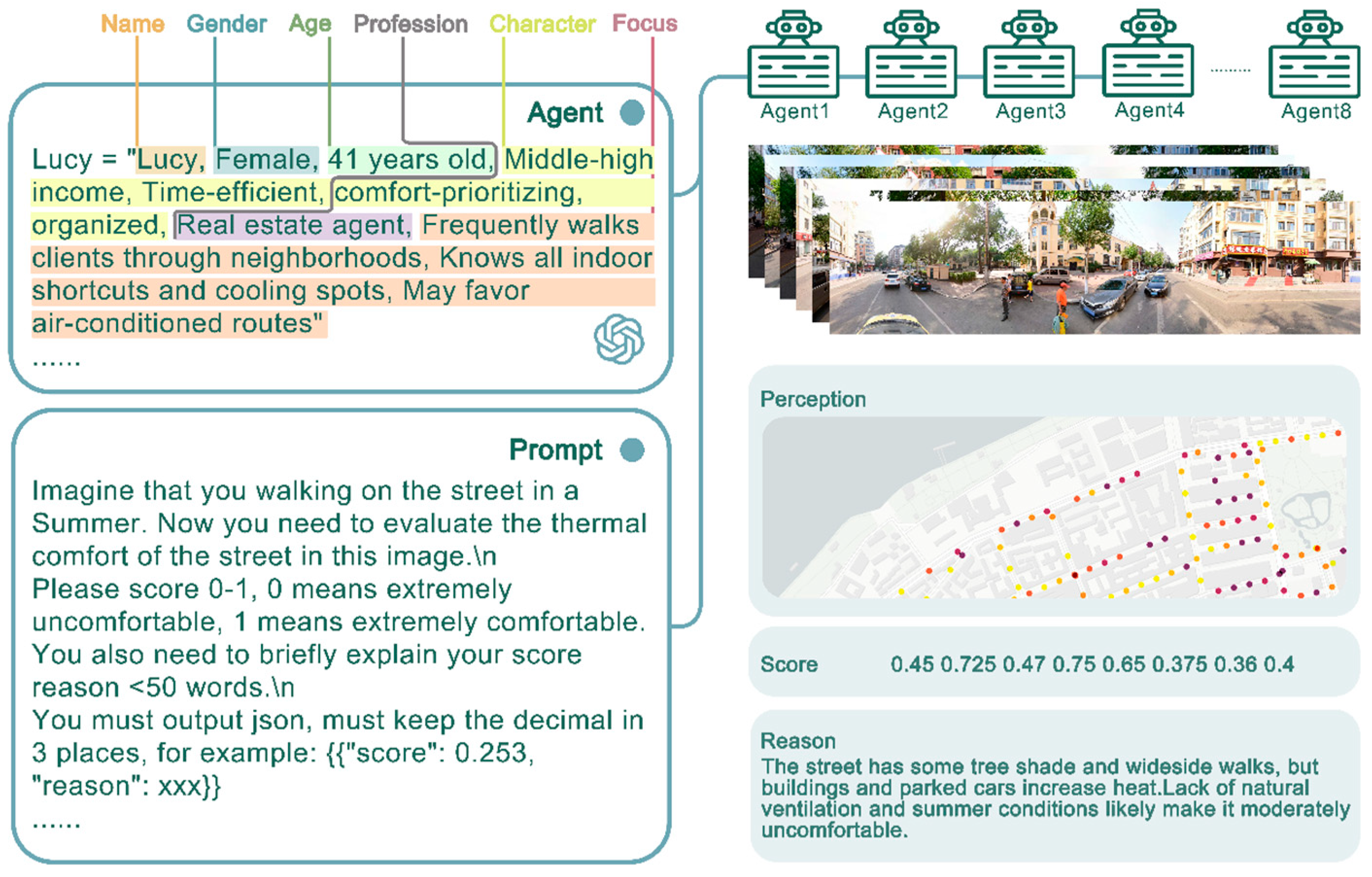
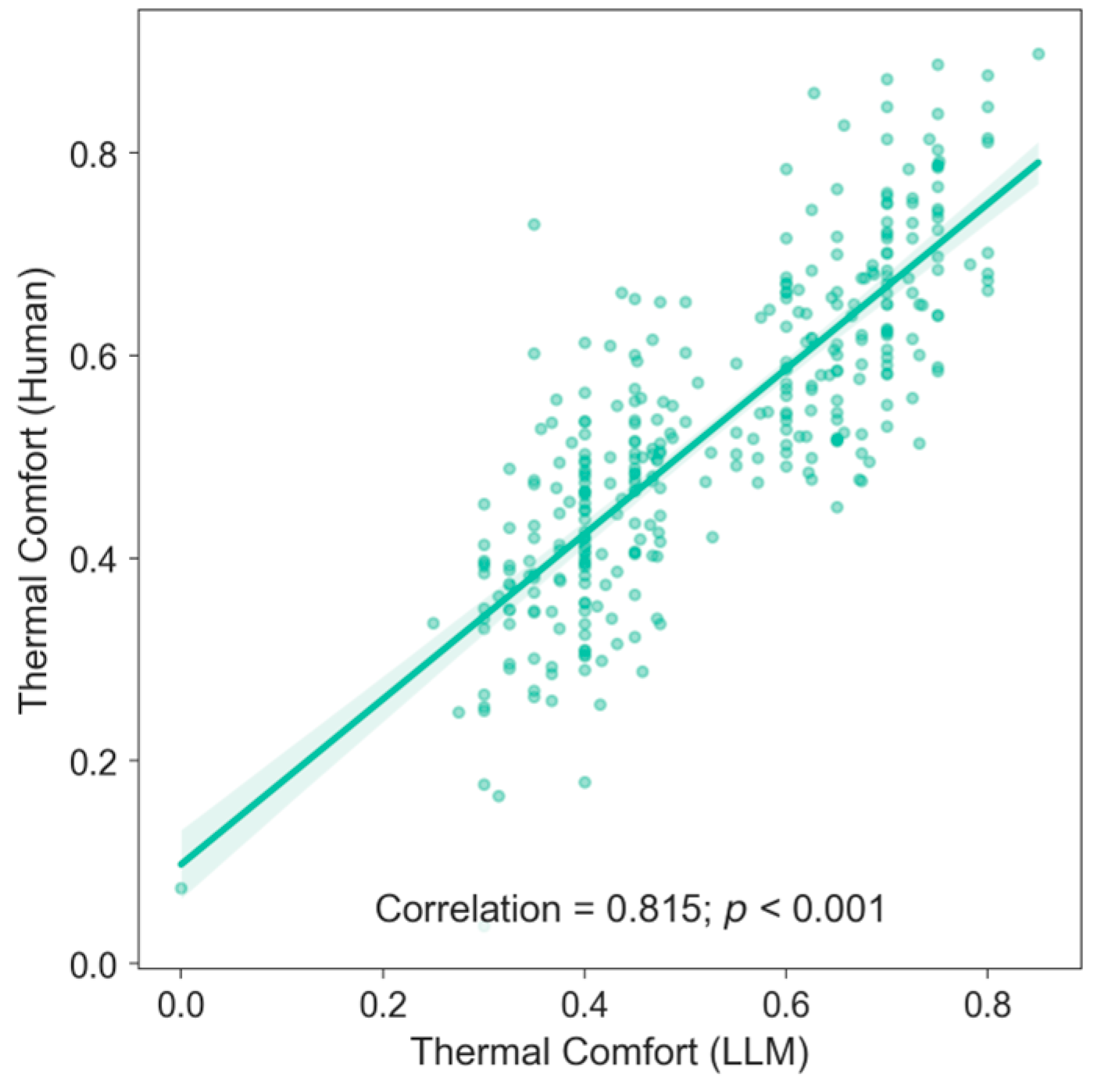

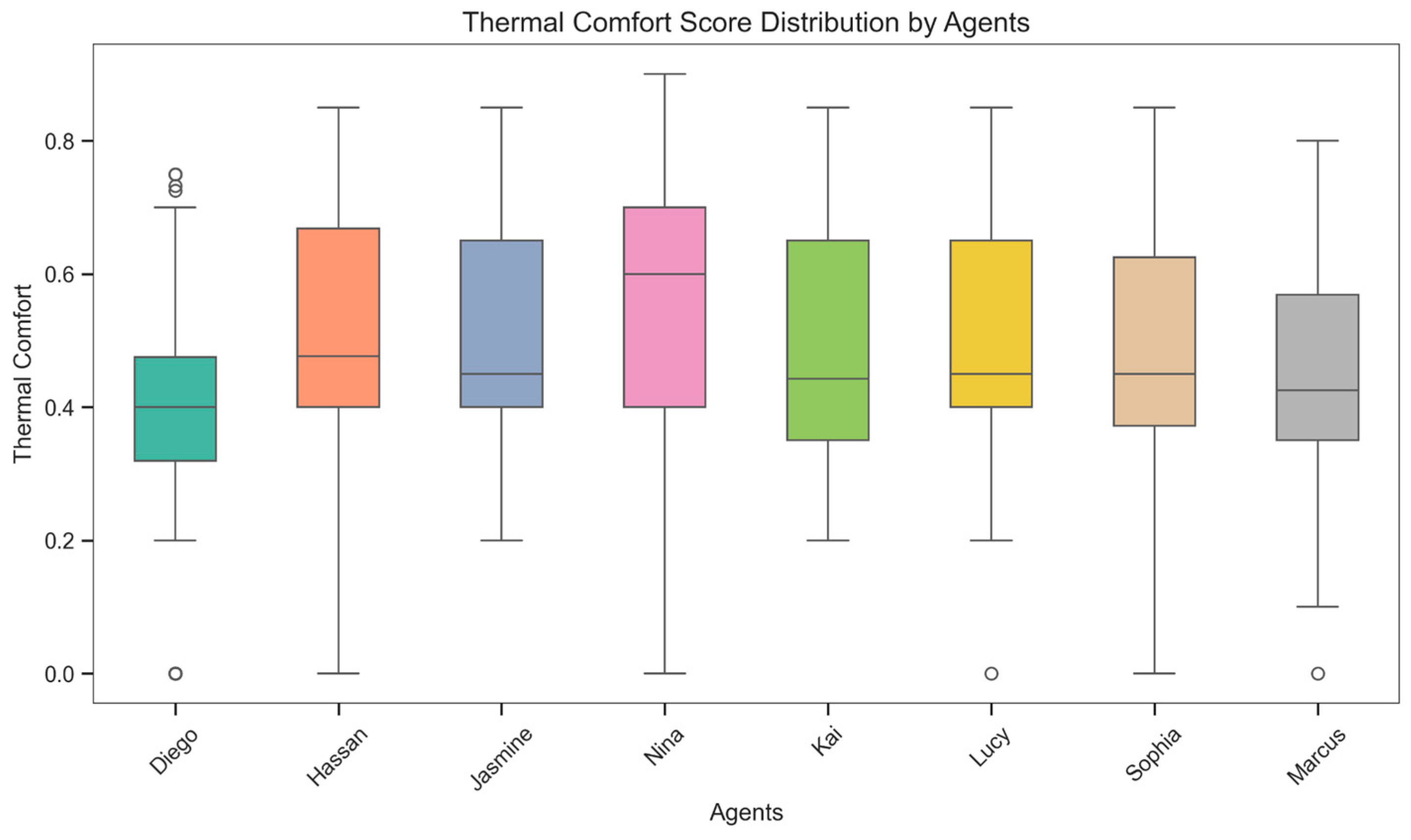
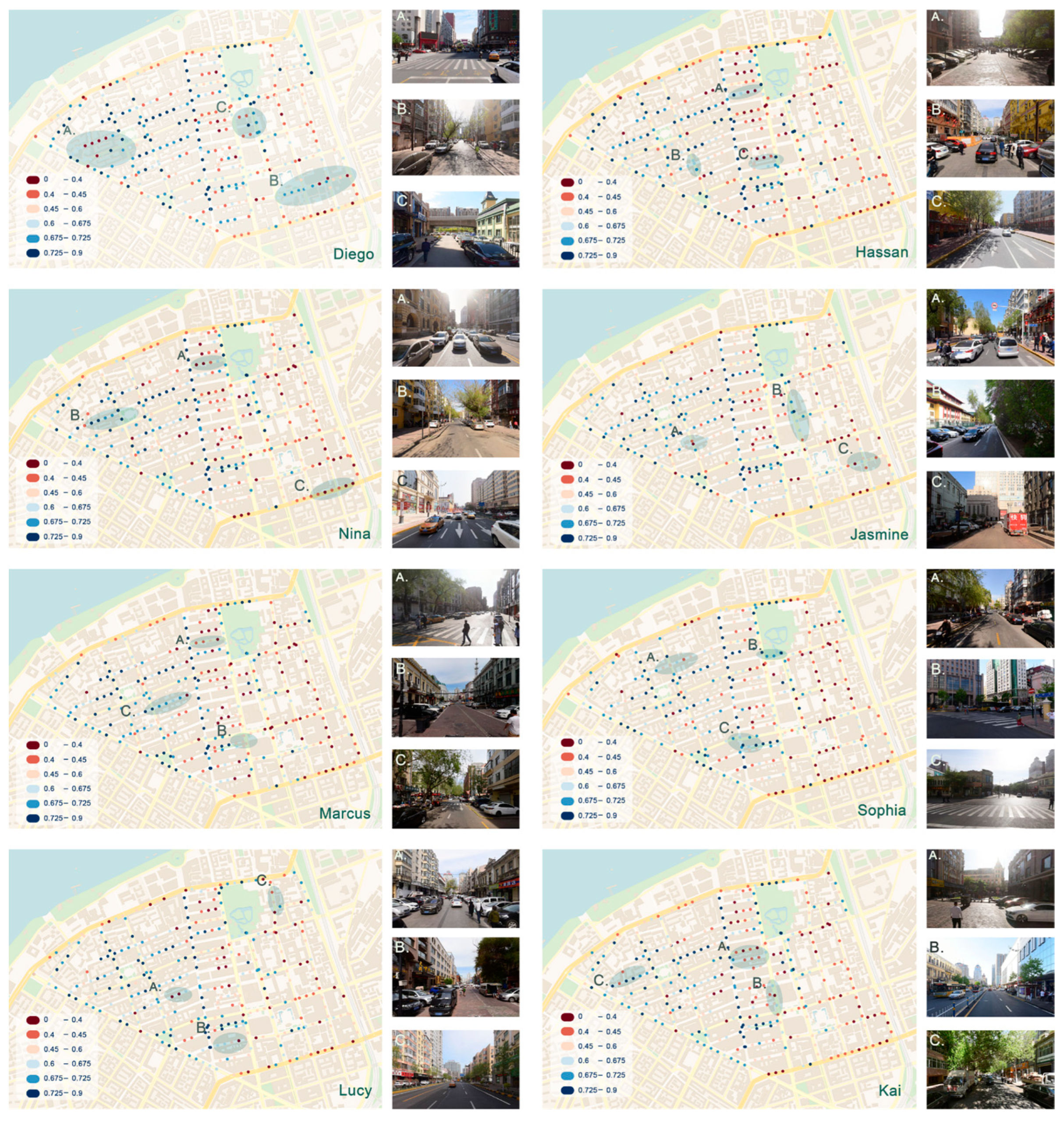
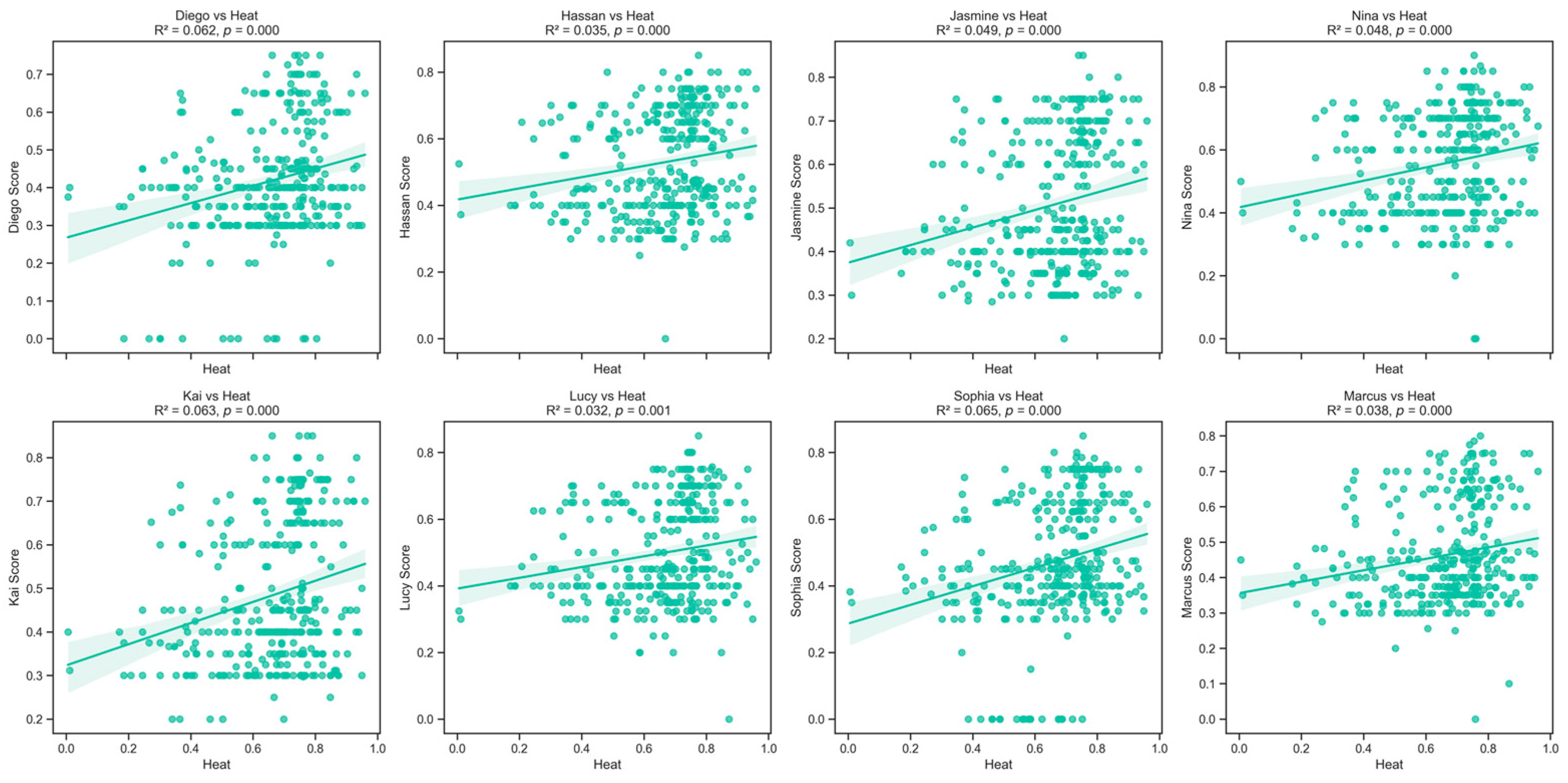
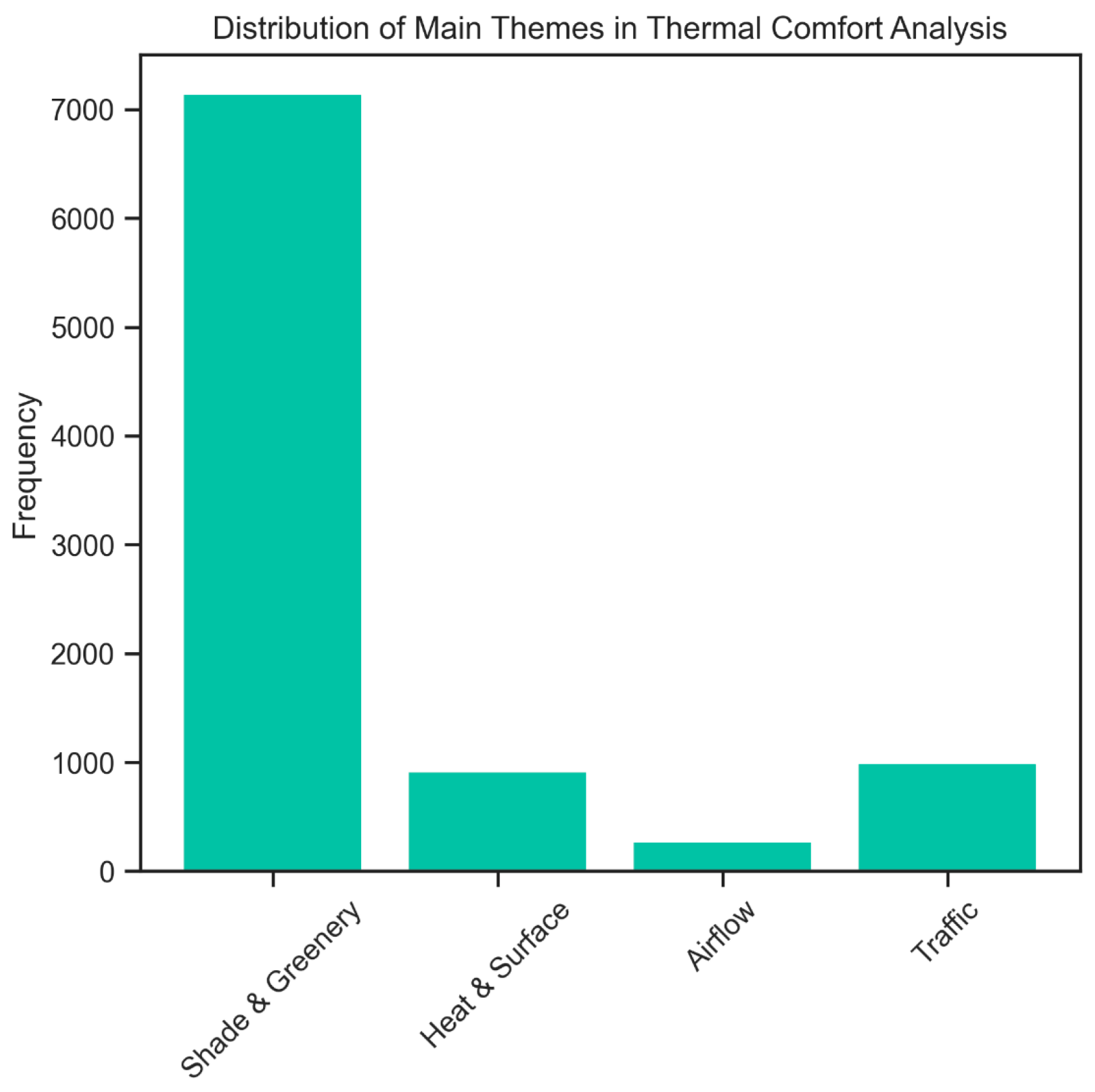

| Num | Name | Age | Gender | Profession | Character | Focus |
|---|---|---|---|---|---|---|
| 1 | Diego | 29 | Male | Food delivery rider | Low-income, energetic, hardworking, resilient | Constantly exposed to outdoor conditions, intimate knowledge of street conditions at different times, sometimes underestimates heat risks due to youth |
| 2 | Hassan | 52 | Male | Works outdoors | Middle-income, practical, weather-wise, observant, street vendor | Expert knowledge of local microclimate conditions, very aware of daily and seasonal patterns |
| 3 | Nina | 60 | Female | Community health worker | Middle-income, health-conscious, careful, nurturing | Exercise routine, knows all drinking fountains and rest spots, very attuned to seniors’ needs |
| 4 | Jasmine | 38 | Female | Yoga studio owner | High-income, wellness-focused, mindful, selective | Sensitive to environmental conditions, prefers walking in nature, may avoid certain areas based on ’energy’ feelings |
| 5 | Marcus | 45 | Male | Climate researcher | Middle-income, detail-oriented, systematic, analytical | Professional temperature monitoring devices, expertise in urban heat islands, may over-rely on data and ignore subjective feelings |
| 6 | Sophia | 32 | Female | Fashion-conscious | Middle-high income, fashion-conscious, sensitive to weather | Walks frequently between stores, very aware of shaded areas and air-conditioned spaces, may prioritize appearance over comfort |
| 7 | Lucy | 41 | Female | Real estate agent | Middle-high income, time-efficient, comfort-prioritizing, organized | Frequently walks clients through neighborhoods, knows all indoor shortcuts and cooling spots, may favor air-conditioned routes |
| 8 | Kai | 25 | Male | Urban studies graduate student | Student income, environmental activist, passionate, idealistic | Researches green infrastructure, expert in sustainable urban design, may be overly critical of existing infrastructure |
| Number | Topic | Keywords |
|---|---|---|
| 1 | Shade and Greenery | Shade | tree | greenery | vegetation |
| 2 | Heat and Surface | Heat | concrete | asphalt | reflect |
| 3 | Airflow | Airflow | ventilation | wind | breeze |
| 4 | Traffic | Traffic |vehicle |car | bus |
Disclaimer/Publisher’s Note: The statements, opinions and data contained in all publications are solely those of the individual author(s) and contributor(s) and not of MDPI and/or the editor(s). MDPI and/or the editor(s) disclaim responsibility for any injury to people or property resulting from any ideas, methods, instructions or products referred to in the content. |
© 2025 by the authors. Licensee MDPI, Basel, Switzerland. This article is an open access article distributed under the terms and conditions of the Creative Commons Attribution (CC BY) license (https://creativecommons.org/licenses/by/4.0/).
Share and Cite
Zhang, D.; Xiong, Z.; Zhu, X. Evaluation of Thermal Comfort in Urban Commercial Space with Vision–Language-Model-Based Agent Model. Land 2025, 14, 786. https://doi.org/10.3390/land14040786
Zhang D, Xiong Z, Zhu X. Evaluation of Thermal Comfort in Urban Commercial Space with Vision–Language-Model-Based Agent Model. Land. 2025; 14(4):786. https://doi.org/10.3390/land14040786
Chicago/Turabian StyleZhang, Dongyi, Zihao Xiong, and Xun Zhu. 2025. "Evaluation of Thermal Comfort in Urban Commercial Space with Vision–Language-Model-Based Agent Model" Land 14, no. 4: 786. https://doi.org/10.3390/land14040786
APA StyleZhang, D., Xiong, Z., & Zhu, X. (2025). Evaluation of Thermal Comfort in Urban Commercial Space with Vision–Language-Model-Based Agent Model. Land, 14(4), 786. https://doi.org/10.3390/land14040786






